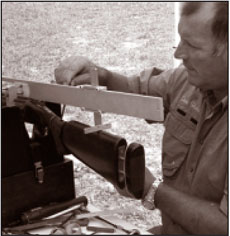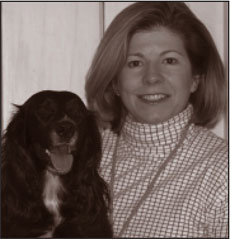THE GUEST COLUMNS:
A NEW ADDITION
The Gazette has been an amazing success,
with the requests to be included on the mailing lists
grow daily, the publication itself is matching the growth.
In an attempt to keep the content fresh, informative and
interesting, I have asked friends in the industry, both
professional and just keen sportsmen and women, to submit
contributions.
In this edition you will find the first sprinkling
of these; I hope you enjoy them and please feel free to
let me know your thoughts on the content and on any subject
you would like to see covered. (How To Sell Your Gun came
from a reader’s suggestion.)
This Quarter, among our
guests, The Double Gun Journal’s Michael Sabbeth
covers the introduction of the new Berretta SO10, a true
Italian jewel and Sports-A-Field’s John Taylor dispenses
some sage advice on cartridges, Damascus barrels and gunfitting.
MY OLD SHOTGUN!
I answer many letters for the National
Rifle Association that inquire if a particular Damascus-barrel
double can be fired with “low-brass” loads?
There seems to be some persistent idea that the height
of the metal head on a shotshell determines pressure.
Nothing could be farther from the truth! Both low-brass
and high-brass shotshells can generate pressures well
above the safe limits of even the best, nitro-proofed
Damascus/twist barrels.
I own several Damascus-barreled
shotguns that could not be safely fired with any ammunition.
However, following a trip to Briley Manufacturing Co.,
(1230 Lumpkin, Houston, TX 77043; phone: 800-331-5718),
I can enjoy them, albeit in a smaller gauge.
Briley, following a careful
inspection, will hone out the original barrels to lighten
them, then make a custom set of fulllength tubes, 20-
or 28-gauge in an original 12-bore are recommended, these
are complete with screw-in chokes. Thus equipped, we can
shoot our heirloom shotguns with safety and enjoyment.
John
M. Taylor
|
|
THE IMPORTANCE OF GUN FIT

Combined with a solid
gun mount, a properly-fitted stock that delivers the shotgun's
patterns to a precise and predictable point of impact is
the key to good shotgun marksmanship.
There is often a reluctance
on the part of shooters to be fitted. Many shotgunners seem
to believe that a fitting leads exclusively to an expensive
new stock. That's not true. Stock bending, pads, add-on
combs, etc. can inexpensively adjust an existing stock.
Recently, Chris Batha fitted
me prior to having my Henry Atkin restocked (the original
stock was oil-soaked and unsalvageable) and ordering a Perazzi
sporter, and before the completion of my Ithaca just prior
to Ithaca Classic Doubles declaring bankruptcy. In each
case, the point of impact of each gun was precisely where
I wanted it and the fitting dictated.
Many shooters restock their
shotguns for looks, without regard to fitting. Others are
content with a five-minute "fitting" using a flashlight
in the bore from a dealer who hasn't the slightest idea
of how a shotgun is fitted. Only by shooting at a plate
can a fitting be accomplished, and it often takes hours,
not minutes. However, once the proper dimensions are derived,
they become an integral part of excellent shotgun marksmanship.
John M. Taylor
7819 Stovall Court
Lorton, VA 22079-4330
703-339-6415
|
|
|
The
Art of Shooting
An Expert's Point of View
A natural extension of shooting is the collecting of sporting
paintings. Of interest to shooting enthusiasts may be scenes
of hunting or paintings of gun dogs— either antique
or contemporary. Some collectors might limit their interest
to American or English paintings, others to the breed of dog
they own.
Learning about paintings can
be an interesting and exciting venture. Sporting auctions
can be a great place to see a variety of painting styles and
quality. Buying at auction, however, is not always for the
neophyte, and a good art adviser can help make your foray
into the art world more enjoyable and successful.
The December 27, 2003
issue of The Financial Times devoted an article entitled Some
Help With The Old Masters to the growing popularity of art
advisers, who at one time served only the highest level of
collector. The article states that art advisers may be in
demand for the knowledge and networking they can provide,
or the anonymity they can offer buyers and sellers. Some potential
collectors may have the means but not the expertise, and may
use advisers to negotiate the minefield of the art market.
The most important qualities of an art adviser are integrity
and expertise.
To learn more about the
art market, ask a reputable gallery, museum or auction house
to recommend an adviser in your area of interest.

Susan Quigley is an art
dealer specializing in sporting art and enjoys shooting over
her English Cocker Spaniel, Chough.
She can be contacted at derrymeeting@earthlink.net.
|
Page 6
|

